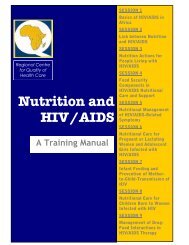Cost and Effective Analysis of the LINKAGES ... - Linkages Project
Cost and Effective Analysis of the LINKAGES ... - Linkages Project
Cost and Effective Analysis of the LINKAGES ... - Linkages Project
You also want an ePaper? Increase the reach of your titles
YUMPU automatically turns print PDFs into web optimized ePapers that Google loves.
Table 6: Relationship Between <strong>Cost</strong>s <strong>and</strong> Outcomes (<strong>LINKAGES</strong> <strong>and</strong> Partner <strong>Cost</strong>s)North Center South17,693 20,065 6,042Number <strong>of</strong>BeneficiariesIndicator <strong>Cost</strong> PerBeneficiaryPCTChg inIndicator<strong>Cost</strong> PerBeneficiaryPCTChg inIndicator<strong>Cost</strong> PerBeneficiaryPCTChg inIndicatorLAM User Rate $33,755 $1.91 6.78% $43,909 $2.19 4.47% $19,323 $3.20 3.28%6.2. What are Determinants <strong>of</strong> <strong>Cost</strong>s <strong>and</strong> <strong>Cost</strong> <strong>Effective</strong>ness?Overall Finding The cost <strong>of</strong> training activities <strong>and</strong> IEC are <strong>the</strong> key cost drivers. Thekey factors affecting cost effectiveness include baseline <strong>and</strong> outcome behaviorchange rates <strong>and</strong> <strong>the</strong> size <strong>of</strong> targeted population.Higher total cost or cost per beneficiary does not necessarily imply lower or higher cost effectiveness(defined as cost per new acceptor). Many factors affect total costs <strong>and</strong> cost effectiveness. <strong>Cost</strong>s aredisaggregated in a variety <strong>of</strong> ways to examine patterns among different types <strong>of</strong> costs, <strong>and</strong> factors thataffect cost effectiveness.6.2.1. Key <strong>Cost</strong> DriversThe cost patterns in <strong>the</strong> three regions are similar – costs were concentrated in BF/LAM trainingactivities (60% <strong>of</strong> costs in <strong>the</strong> Center, 58% in <strong>the</strong> North, <strong>and</strong> 54% <strong>of</strong> costs in <strong>the</strong> South region), withIEC, mo<strong>the</strong>r-to-mo<strong>the</strong>r support group activities, <strong>and</strong> monitoring <strong>and</strong> evaluation <strong>the</strong> next largest costcomponents.Although BF/LAM training is clearly <strong>the</strong> highest cost activity in all regions, <strong>the</strong>re are regionaldifferences in <strong>the</strong> cost per beneficiary. Table 7 shows <strong>the</strong> cost <strong>of</strong> each activity by region. TotalBF/LAM training cost per beneficiary in <strong>the</strong> North is $1.06, in <strong>the</strong> Center $1.32, <strong>and</strong> in <strong>the</strong> South$1.73.There is a difference in <strong>the</strong> proportional distribution <strong>of</strong> MTMSG activity costs across <strong>the</strong> regions.They comprise 3% <strong>of</strong> total costs in <strong>the</strong> North, 7% in <strong>the</strong> Center, <strong>and</strong> 11% in <strong>the</strong> South. Fur<strong>the</strong>r, <strong>the</strong>MTMSG costs per beneficiary were six times higher in South ($0.36) than in North ($0.06), <strong>and</strong> twicethat <strong>of</strong> <strong>the</strong> Center region ($0.16).Ano<strong>the</strong>r notable difference in <strong>the</strong> proportionate distribution across <strong>the</strong> regions can be found in IECcosts. IEC costs represent 20% <strong>of</strong> <strong>the</strong> total costs in <strong>the</strong> North <strong>and</strong> 13% <strong>of</strong> costs in <strong>the</strong> Center. On aper beneficiary basis, <strong>the</strong> costs in <strong>the</strong> North ($0.38) were 31% higher than in <strong>the</strong> Center region($0.29). Even though total IEC costs in <strong>the</strong> South were lower than in <strong>the</strong> North <strong>and</strong> Center regions,cost per beneficiary ($0.54) was 86% higher than in <strong>the</strong> Central region <strong>and</strong> 42% higher than in <strong>the</strong>North. This is due to <strong>the</strong> fact that <strong>the</strong> coverage population in <strong>the</strong> North was triple <strong>and</strong> in <strong>the</strong> Center3.3 times that in <strong>the</strong> South.<strong>Linkages</strong> <strong>Project</strong>/AED 6. Findings 19
















